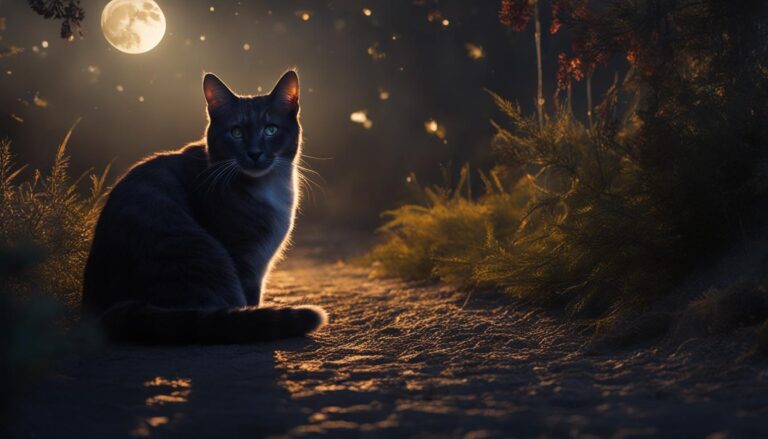Are cats nocturnal? Have you ever wondered why your feline friend seems to be most active when the sun goes down? Understanding cat behavior and their sleeping patterns can shed light on their nighttime habits.
Cats have a well-designed sleeping schedule honed by evolution. Their wild ancestors, who were successful hunters, would hunt their prey at dawn and dusk when the dim light made it easier to sneak up on their targets.
Domesticated cats have maintained this sleep schedule, although many have adjusted to match their human family’s waking hours. But are they truly nocturnal creatures? Let’s dig deeper to find out.
Punti di forza:
- Cats are crepuscular animals, meaning they are most active during dawn and dusk.
- Understanding and managing their nighttime activity can create a harmonious living environment.
- Cats require 13 to 16 hours of sleep per day for mature adults and up to 20 hours for kittens and young cats.
- By providing mental and physical stimulation during the day, you can help regulate their sleep schedule.
- Establishing a routine that aligns with your own sleep schedule can ensure a restful night’s sleep for both you and your furry friend.
Understanding Crepuscular Behavior
Cats are not strictly nocturnal animals; instead, they are crepuscular, which means they are most active during dawn and dusk. This behavior is instinctive and is rooted in the hunting habits of their wild ancestors. Cats have excellent night vision, allowing them to hunt in low-light conditions. They are typically most active during these crepuscular hours, making them playful and energetic during the early morning and evening.
Unlike nocturnal animals, cats do not sleep during the day. While they may take short naps, they remain alert and aware of their surroundings. This is because their survival instincts make them constantly vigilant for any potential threats or sources of food. Their acute night vision and heightened senses allow them to navigate and hunt efficiently during the dim lighting of dawn and dusk.
Understanding crepuscular behavior is essential for cat owners, as it helps them create an environment that accommodates their cat’s natural instincts. Providing interactive playtime and mental stimulation during the crepuscular hours can help satisfy their hunting instincts and promote their physical and mental well-being. Engaging in play and interactive activities during these times can help alleviate any pent-up energy and prevent disruptive behavior during the night.
Cats’ Night Vision
One of the reasons cats are more active during dawn and dusk is their superior night vision. Cats possess a specialized structure in their eyes called the tapetum lucidum, which reflects light back through the retina, enhancing their night vision. This structure acts like a natural ‘mirror’ that amplifies the available light, allowing them to see clearly in low-light conditions. Additionally, their eyes contain a higher concentration of rod cells, which are responsible for detecting light and motion, further enhancing their ability to see in the dark.
The combination of their night vision and crepuscular behavior makes cats excellent hunters during the twilight hours. So, if you ever spot your feline friend prowling around the house during dawn or dusk, remember that they are simply following their natural instincts rooted in their wild ancestry.
Table: A Comparison of Nocturnal, Diurnal, and Crepuscular Animals
| Animal | Active during the Day? | Active during the Night? | Active during Dawn and Dusk? |
|---|---|---|---|
| Nocturnal | No | Sì | No |
| Diurnal | Sì | No | No |
| Crepuscular | No | No | Sì |
Managing Your Cat’s Nighttime Activity
If you have a feline friend that tends to keep you up at night, it’s important to find strategies to manage their nighttime activity. One key aspect to consider is understanding their innate hunting behavior. Cats are natural predators, and their need to hunt and explore can lead to nighttime disruptions.
Playing with your cat before bedtime can help tire them out and release some of their pent-up energy. Interactive toys that simulate hunting can engage their natural instincts and provide them with mental and physical stimulation. These activities can help exhaust their energy levels and encourage them to settle down for a good night’s sleep.
It’s also crucial not to engage with your cat’s nighttime behavior. Responding to their demands, such as meowing or scratching at the door, only reinforces their disruptive actions. Stay consistent and avoid giving in to their pleas for attention during the night.
Providing mental stimulation during the day can also help keep your cat occupied and less prone to disruptive behavior at night. Consider offering puzzle toys or treat dispensers that require them to work for their food. This can satisfy their natural need to hunt and keep their minds active throughout the day, leading to a calmer night ahead.
| Strategies for Managing Your Cat’s Nighttime Activity |
|---|
| Play with your cat before bedtime to tire them out |
| Use interactive toys that simulate hunting and provide mental stimulation |
| Avoid engaging with your cat’s disruptive behavior during the night |
| Provide mental stimulation during the day with puzzle toys or treat dispensers |
Adjusting Your Cat’s Schedule
If you find that your cat’s nocturnal behavior is causing disruptions to your sleep, don’t worry – there are ways to adjust their schedule to better suit your lifestyle. Gradually shifting their playtime to the daytime can help regulate their sleep patterns and encourage them to be more active during the day. By engaging them in interactive play sessions and providing mental stimulation, you can help tire them out and ensure a more peaceful night’s sleep for both of you.
Creating a designated play space away from your bedroom can also help establish boundaries and prevent your cat from disturbing your sleep. Make sure to provide plenty of toys and scratching posts to keep them entertained and engaged during the day. Interactive puzzle toys are particularly effective in keeping cats mentally stimulated and reducing nighttime restlessness.
Additionally, maintaining a consistent daily routine can help reinforce your cat’s adjusted schedule. Feed them at the same time each day and establish a regular bedtime routine that signals it’s time to wind down. This could include brushing their coat, providing a relaxing environment with dim lighting, or playing calming music. Consistency is key when it comes to helping your cat adapt to a new sleep schedule.
Adjusting Your Cat’s Schedule Table
| Activity | Daytime | Nighttime |
|---|---|---|
| Playtime | Engage in interactive play sessions and provide mental stimulation | Avoid engaging with their behavior during the night to discourage nighttime activity |
| Sleeping Area | Designate a play space away from your bedroom | Create a peaceful sleeping environment in your bedroom for uninterrupted sleep |
| Feeding | Establish a consistent feeding schedule during the day | Stick to the same feeding routine, avoiding late-night feedings |
| Routine | Develop a regular daytime routine to tire your cat out | Establish a bedtime routine that signals it’s time to wind down |
By implementing these strategies and adjusting your cat’s schedule, you can help promote healthier sleep patterns and ensure a more peaceful coexistence with your feline companion.
Understanding Cats’ Sleeping Patterns
Cats have unique sleeping patterns that are influenced by their evolutionary history and natural instincts. Mature adult cats typically need 13 to 16 hours of sleep a day, while kittens and young cats require even more, often up to 20 hours. This extended sleep time allows cats to conserve energy and recharge for their active periods.
Unlike humans, cats experience both non-REM and REM sleep. During non-REM sleep, cats are in a deep sleep state, but even then, they remain alert and ready to respond to any potential threats or food sources. This vigilance is an inherent survival mechanism that has been passed down from their wild ancestors, who needed to be constantly aware of their surroundings.
To better understand cats’ sleeping patterns, it’s essential to recognize that they do not sleep in long, uninterrupted stretches like humans do. Instead, cats engage in a polyphasic sleep pattern, meaning they take multiple short naps throughout the day and night. These naps can range from a few minutes to a couple of hours, allowing cats to maintain a level of alertness and be ready for action at a moment’s notice.
| Sleeping Patterns | Descrizione |
|---|---|
| REM Sleep | During REM sleep, cats may twitch their whiskers, paws, or even vocalize. This stage is believed to be when cats dream. |
| Deep Sleep | In deep sleep, cats are in a restful state and are less likely to be easily awakened. |
| Light Sleep | During light sleep, cats are more likely to wake up easily and be alert to their surroundings. |
Understanding cats’ sleeping patterns can help cat owners provide the appropriate environment and support for their feline companions. Ensuring a comfortable sleeping area, free from disturbances and noise, can help cats get the rest they need. Additionally, providing mental and physical stimulation during the waking hours can help cats expend energy and promote better sleep quality.

Why Do Cats Sleep During the Day?
Cats’ sleeping patterns are influenced by their crepuscular nature, meaning they are most active during dawn and dusk. This behavior is instinctive and rooted in their natural hunting instincts. Cats sleep during the day to conserve energy for their active periods when prey is more likely to be available. Additionally, sleeping during the day allows cats to adapt to their human families’ schedules, as many cats have adjusted their sleep patterns to align with their owners’ waking hours.
Conclusione
Understanding and managing the behavior and sleeping patterns of cats is essential for creating a harmonious living environment for both feline companions and their human families. While cats are not strictly nocturnal, their crepuscular nature means they are most active during the early morning and evening hours. By providing mental and physical stimulation during the day, you can help tire your cat and promote a better sleep routine.
It’s important to note that cats do sleep during the day, and their sleep patterns differ depending on their age. Adult cats typically need 13 to 16 hours of sleep a day, while kittens and young cats require up to 20 hours. However, even during their sleep, cats remain alert and ready to respond to any potential threats or food sources.
To help regulate your cat’s sleep schedule, consider gradually shifting their playtime to the daytime and providing interactive toys for mental stimulation. Creating a designated play area away from the bedroom can also establish boundaries and ensure a peaceful night’s sleep. Additionally, avoiding engaging with your cat’s nighttime demands and establishing a routine that aligns with your own sleep schedule can contribute to a restful night for both you and your furry companion.




